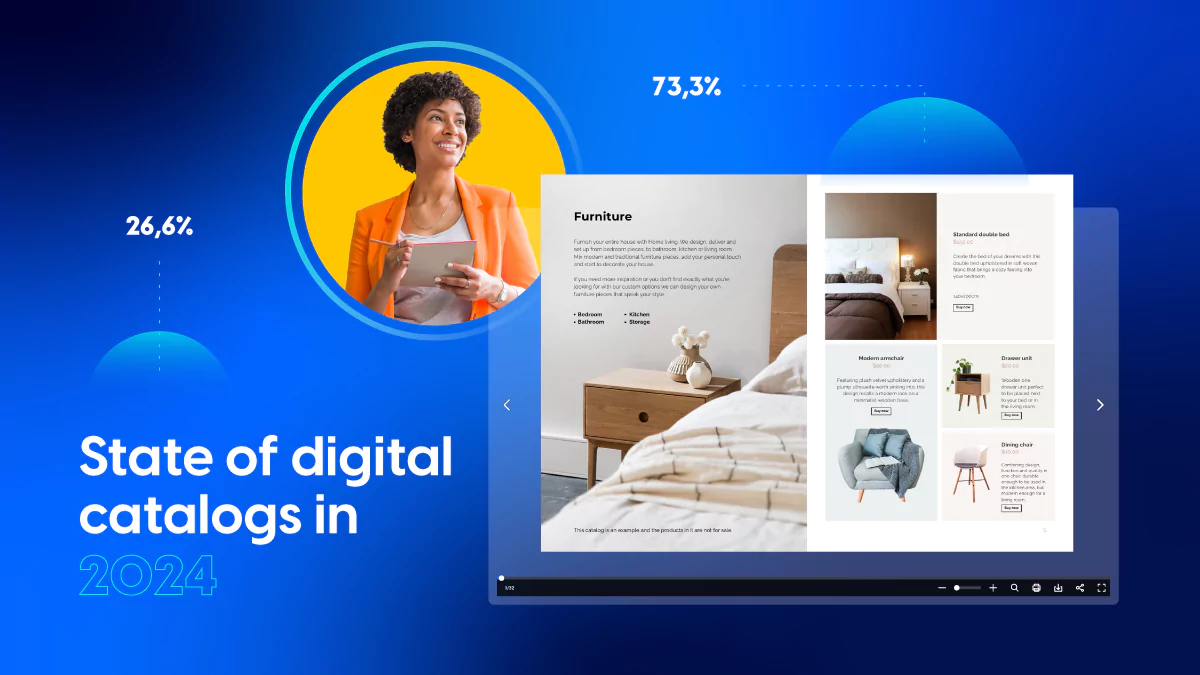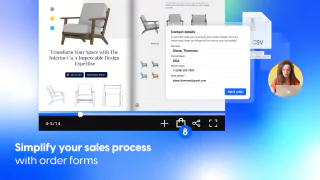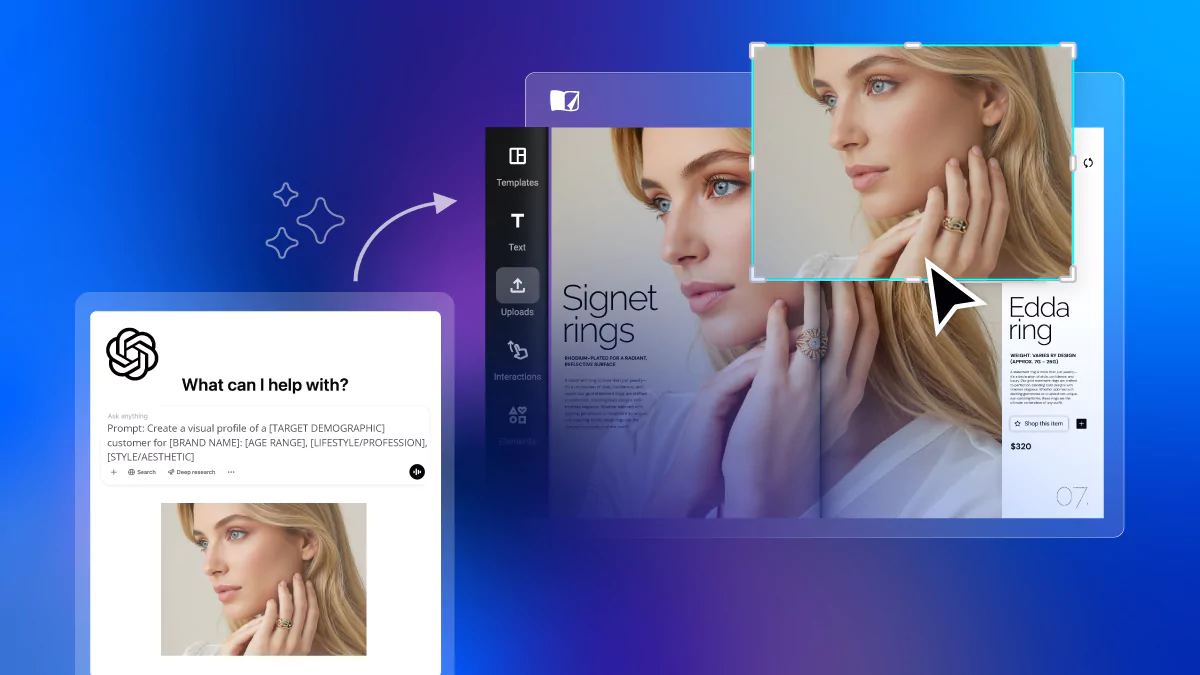Digital catalogs in 2024 – How retailers navigate the new digital era
Catalogs have been around for decades, if not centuries. In all this time, their evolution has been closely observed. Not only by every person who grew up with fashion ideas from Sears, or with Spiegel’s lifestyle trends, but also by every business that wanted to expand their marketing efforts. Even though at the beginning, these catalogs were merely a funnel for showcasing products on a page, the publishers slowly transformed that content into a lifestyle.
Undoubtedly, the printed version of catalogs became much more than this, with an emotional, nostalgic feeling tied to flipping through each catalog you would receive in the mail. This trend was difficult to override with the digital version exactly because of that.
Fast forwarding to today, we notice that digital catalogs are slowly rising to the top as the preferred way of not only shopping, but finding out about new collections much faster than before.
The need for digital catalogs appeared long before the pandemic. However, it surely had a big impact on wholesalers, retailers and implicitly, on consumers. With all companies, no matter the size, not being able to print any physical catalogs, they had to quickly come up with a strategy to digitalize their promotional materials.
Our main goal with this study is to use different instruments to analyze how this environment of digital catalogs evolved over the years. What better way to do that than by accessing our own database and asking our clients, who create and distribute digital catalogs, what they have to say about this matter.
How Jysk UK and Electrolux introduced digital catalogs in their marketing strategy
With more and more companies making the step towards digital-everything, it’s curious to see how different businesses utilize digital catalogs. It can be a valuable tool to use and get ahead of your competitors. We decided to take a closer look at how Jysk UK and Electrolux use digital catalogs for their marketing campaigns. This helps to shed even more light on this fairly new approach and the success they’ve already achieved with it.
Jysk UK
I subscribed to the weekly newsletter from Jysk UK to see what they’re doing to maximize sales in the digital environment via online catalogs. They decided to promote their range of catalogs using the welcome email. Subscribers, like myself, can easily explore the variety of products that Jysk offers, without going out of their way to look for them.
This step is logical in the buyer’s journey, but you are also keeping the shoppers engaged. Making sure they spend as much time browsing through your products as possible. Online catalogs are especially impactful in this format, because they offer an overview of your products. Without being too pushy or making your business seem like it’s trying too hard in the first place.
Jysk UK creates catalogs to be highly inspirational or even promotion driven. The effect it creates is that when readers swipe through a catalog, they will have a clear idea of what you’re selling. Based on this MO, the next time a retailer uses one of the catalogs in an online campaign, their audience will recognize the format and be more inclined to engage with the brand.
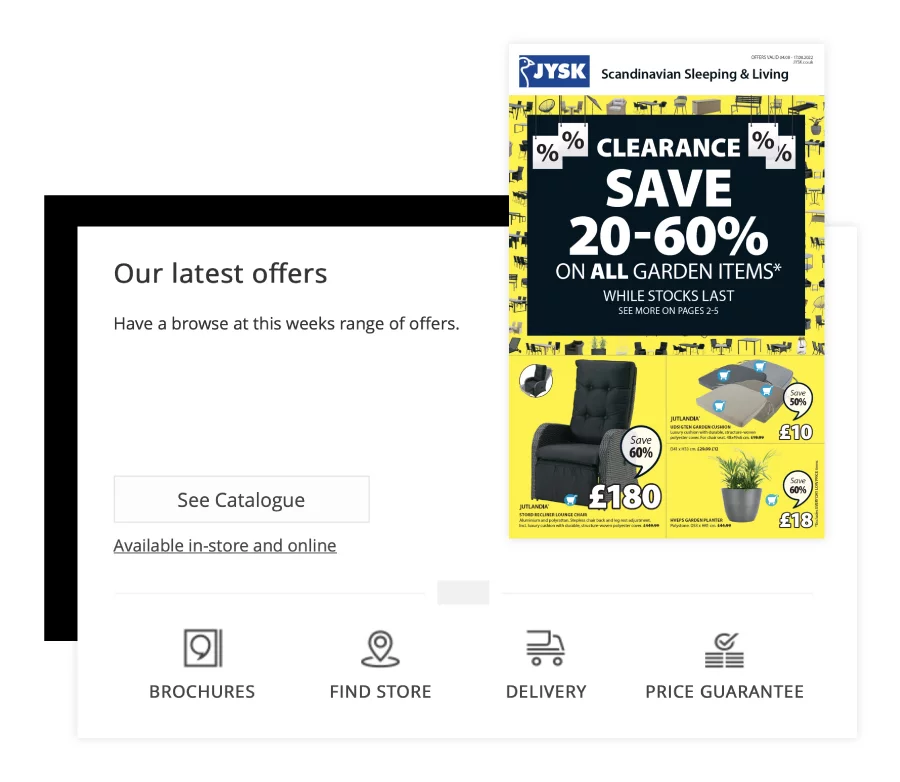
Electrolux
In the case of the Electrolux company, they went a step further and actually created their own app for designing digital catalogs. They are a big business that sells home appliances and were looking for a way to speed up the creation process of digital catalogs.
Before collaborating with NoA Ignite, Electrolux relied only on printed catalogs to spread the word about new collections, deals and seasonal discounts. This solution wasn’t a right fit anymore, with the constant updates on price or products that were included in a catalog. Since adopting this more dynamic approach of a digital catalog creator app, they were able to considerably reduce the time spent on drafting, editing and updating their old printed catalogs and brochures.
Their primary need was related to an efficient sharing option and providing their readers with an immersive reading experience. With access to more interactivity, they transformed their old static PDF catalogs into exactly that. The fact that a digital catalog can have the look and feel of a physical one is another great incentive for upping their game.
However, Electrolux was open to trying other tools on the market and that’s how they ended up creating their catalogs with Flipsnack. With that being said, we should turn our attention to a survey our Flipsnack clients filled out. Discover how they use digital catalogs for their businesses. See what insightful results this thorough research has provided, from what made them switch to digital, to how often they distribute their catalogs and what type of interactivity they use.
Survey data about the use of digital catalogs in 2024
The way businesses use digital catalogs may differ from industry to industry, but we found certain characteristics in common, too. At the beginning of this project, a tiny idea made its way into our brainstorming meeting. Why not send out a survey to our clients who are wholesalers and retailers, and see what they have to say about digital catalogs?
In the infographic below, we wanted to visually present the data we gathered from the survey so it’s easier to understand. This project also helped us understand better the needs and pain points of our clients, tailoring our design tool for their business, on another level.

One of the more interesting finds was that when asked “What made you transition to digital?” 33% responded that it was because of the need to reduce printing costs. This brings more light on how many resources are made available once this cost is removed. Not to mention embracing sustainability on another level. One of our big clients, Fabiola from the Electrolux company, says it best:
Flipsnack is a catalyst in the transition to a more sustainable business. It combines the feeling that a paper catalog gives with interactive and easy-to-use multimedia features that take the user experience to the next level.
Fabiola Vidal, Digital Marketing Product Specialist at Electrolux
Specific data has the power to completely change a business’ direction, and the information above falls in that same category. Once you see the success digital catalogs bring to other similar brands, it would be almost silly to keep your current outdated strategy. There are many reasons why your business can benefit from online catalogs, so see what profit you might be missing out on.
7 reasons why businesses need a digital catalog today
According to Frost & Sullivan, 69% of businesses said they are planning to stop printing their catalogs. In the next five years, they will replace them with online catalogs because of the convenience. More than that, shoppers mostly rely on websites to look for information and purchase products in a convenient way (Ben Mimoun et al. 2014).
This is where digital catalogs come into play, allowing customers to discover new ideas, similar to printed catalogs. More than that, digital catalogs support conventional methods of browsing (e.g. flipping through pages and the page flip sound), thus they mimic the printed catalogs, making them very easy to use.
During a couple of interviews we had with some of our bigger clients, we uncovered real gems which helped us understand more about the print to digital transition in terms of catalogs. Our main focus was discovering exactly how our clients create catalogs, distribute them and if they track their performance. There’ll be snippets from those interviews present throughout the next part, so be on the lookout.
Here are 7 reasons why a business should create a digital catalog in 2024:
- Provides a new kind of shopping
- Keeps up with changed retail expectations
- Boosts sales directly through a digital catalog
- Offer an unforgettable shopping experience
- Encourages product discovery
- Use as a second website
- Enables the option of pre-orders
1. Provides a new kind of shopping
We had the chance to talk to Heather, the Marketing Manager at Velux, which is a company that sells different skylights products. In the interview, she was telling us about the need for a more dynamic channel for their users. This is how they came about creating digital catalogs as part of their way of providing a new kind of shopping experience.
We moved our physical catalogs to digital to offer our readers a more user-friendly platform that’s more dynamic. We were also interested in having sophisticated analytics where we can check how our catalogs are performing from month to month.
Heather Holder, Marketing Manager at Velux
Millennials are particularly engaged by imagery, dynamic elements, videos, anything that makes an effort to grab their attention. The catalog really offers the opportunity to make all those elements stand out. Therefore, the response rate there is very different from what you would expect with a display ad or even email.
During the pandemic, people of all ages were compelled to rely on technology for the most simple needs. Like ordering food from the supermarket or seeing their loved ones. Of course, this is a general argument that helps you understand better the global switch to digital that took place. And favored the use of digital catalogs even more. If before, digitalization was something “nice to have”, now more and more brands have to make the switch to “must have”.
2. Keeps up with changed retail expectations
We are all aware of how fast everything changes both in the digital and physical world. Customers go through many behavior changes in a short period of time. We can track that, especially in the digital environment, using different tools.
Teuta, the Director of Sample Department at Emsig, which is a wholesale company selling high-quality button products, and her team were quick to adjust to their customers’ needs and create the context for easier shopping. This is what she said in her interview with us:
Catalogs are the perfect way to show their products to the customers. They want to see the products first before ordering. They used to sell real catalogs, but customers now prefer to see a digital version of the catalog. Digital catalogs allow them to display products in a cool way.
Teuta Selimi, Director of Sample Department at Emsig
This is another piece of evidence that these days, shoppers carry out product research digitally. Their retail expectations have evolved way past printed catalogs sent to their house, so you need to meet them in the right communication channel. Instead of visiting the in-store showroom, customers want simple electronic access to all of your products. The obvious solution is digital catalogs, making your brand known to future online shoppers.
Thinking about how hard it is to measure the impact of a printed catalog, statistics are a great way to track the effectiveness of digital catalogs. See who opens them, what pages they spend more time on, what elements they click on, and so on. This qualitative data access from using a tool helps you track catalog performance every time you distribute one online. Then, take into account the interpreted data to make targeted changes, while keeping up with the new retail expectations.
3. Boosts sales directly from the online catalog
Upon reading the survey answers we got from our clients, there were a few that measured the impact digital catalogs have on their business. Reading about a 20-40% increase in sales and even 40-60% made us all the more impressed with how much this extra outlet where potential customers can find out about your products adds to your profit.
The cool thing about this is that you can spread the word about your catalogs through email, on social media, on your website. Later, we’ll tackle the various ways to distribute digital catalogs, so stay tuned.
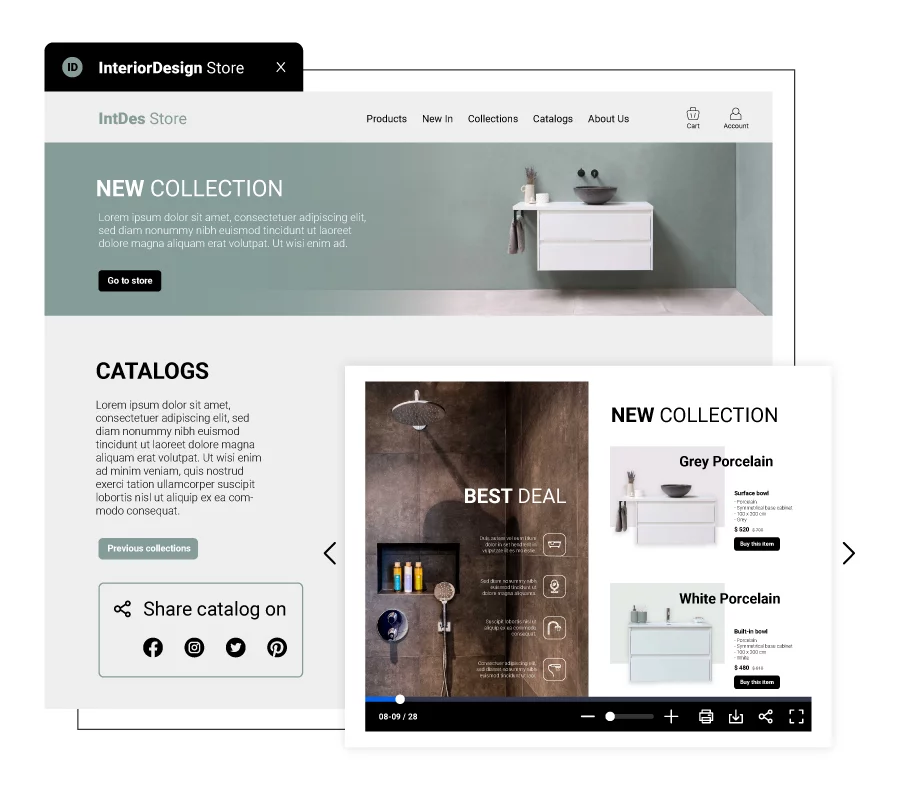
Digital catalogs can be integrated with Shopify if you already have an ecommerce store, or a B2B eCommerce website platform, up and running. Product tags and buy buttons with more details about the product helps the visitor make an informed decision about your brand. This way, visitors can buy directly from the catalog, eliminating the extra step which would take them to the website. In the usual buyer’s journey, it’s crucial to answer any questions through the catalog copy and then shorten the steps a potential buyer needs to make in order to purchase from you.
We also have users who embed the catalog on their homepage, or in the monthly newsletter. Both contributing to advancing today’s online shoppers along the buying journey. I’ll say it again: constantly showing up to where your audience spends most time online will get them more accustomed to your products. Choosing digital catalogs as a primary funnel can really get that ball rolling.
4. Offers an unforgettable shopping experience
Online catalogs provide your visitors with an immersive brand encounter. In that process, they discover your brand with a familiar and inspiring shopping experience. According to one report, 72% of people surveyed said that browsing a catalog made them more interested in a retailer’s products. But the percentage of people who bought a product after seeing it in a catalog is powerful: 84%. However, that shouldn’t surprise you, since we all are visual creatures. Once you understand this, it’s easy to see why we respond to visual information better than to any other format.
The same experience Stephanie from Three Sticks Wines had, after implementing digital catalogs in their strategy:
Switching to digital catalogs or lookbooks really had an impact on the engagement. The average reader spent nearly 4 minutes reading a 12 page document and that is amazing. We are planning on digitizing more of our marketing collateral in the near future.
Stephanie Brereton, Marketing Coordinator at Three Sticks Wines
Online catalogs have the power to win over clients from the competition, acquire new customers, all within the comfort of digitization. The page-flip effect equates with the printed copies they used to receive. Interactions can be added to maximize the potential of creating a truly unforgettable experience. Photo slideshows, product tags, buy buttons, embedded videos are just a few examples.
There are many ways to go about online catalogs with a clear impact on your sales, so make sure to stick around while we’ll discuss that retail campaign how-to.
5. Encourages product discovery
There’s this study showing that 54% of online shoppers are searching for a specific item. That is, compared with 76% which do the same thing in-store. All the more reasons to put your catalog online and guide the shoppers through discovering more products from you. This tactic gives them a logical starting point in their buying journey.
This channel is an effective way to entice potential customers with your latest products presented in an engaging way. When videos, photo slideshows, and product tags are combined, a more dimensional storytelling is created for the audience. For this to work, a big focus should be on making the catalogs mobile optimized, since such a high percentage of users are flipping through catalogs on their mobile devices.

Additionally, fashion retailers can produce catalogs seasonally to encourage clients to browse through the most recent digital offers while awaiting the publishing of the next catalog. What this ultimately does is an online catalog that becomes a default section on your ecommerce store. And that takes us to the next benefit: using online catalogs as a second website.
6. Use as a second website
We have come across the idea that digital catalogs make it simpler for customers to find stores online. More than that, Google wants to see content on a retailer’s website. By indexing the pages, it learns more about that website. This is how more people can find out about the showcased products. Linking the products to the ecommerce store directly increases the sales one has when using the catalog as a funnel.
Stephanie, in our interview, talked about this exact benefit when dealing with digital catalogs for the wine company she works at:
We also want to make flipbooks for all of our vineyards so that the wholesale department can send them out digitally and talk about them. This way, we can drive the traffic onto our website.
Stephanie Brereton, Marketing Coordinator at Three Sticks Wines
There’s another angle from which to tackle this benefit. Retailers may easily enter into the world of e-commerce with the help of digital catalogs. When there’s a wide range of products, users of different kinds can find what they’re looking for on the website. The more details digital catalogs provide, the more prepared customers are to make purchases from a certain brand.
In the end, shoppable catalogs are a spin on e-commerce for companies needing a more distinctive method of presenting their products to buyers. A shoppable catalog, similar to e-commerce, will set a retailer apart from your competitors, while blending in naturally with their website.
7. Enables the option of pre-orders
A shoppable catalog is a useful resource for placing pre-orders. Even out-of-stock products can be ordered by customers. This is useful since it enables retailers to manage inventory, assess demand, and establish contact with potential customers. Customers also enjoy the convenience of pre-orders. They are able to order what they want and pay for it later when they pick it up. This is not only practical for everyone, but it’s also a great way to manage stock with wholesalers.
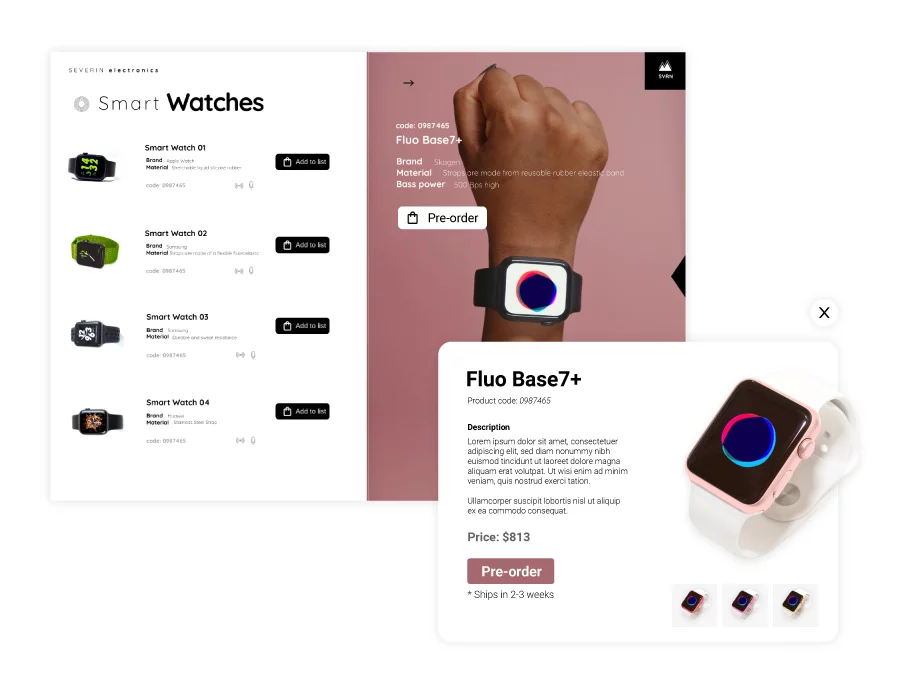
Needless to say that online catalogs come packed with benefits, making it one of the most powerful marketing tools that any business can own. Once the process of creating catalogs for seasonal campaigns or featuring new collections is on the go, the return on investment will be worth it.
Why should retailers that already invested in an ecommerce store be interested in using digital catalogs, as well? That’s the question we’ll be answering in the following section, along with big brands that have already adopted this good practice.
The point of digital catalogs with an ecommerce store
Digital catalogs, when used right, assist in seizing new opportunities. You can enhance sales, work with new suppliers, expand into new channels, and more using online product catalogs. Managing an online catalog as your second website means you’re making them a valuable and long-lasting channel where your audience can go see your most recent apparel lines or be directed if they have subscribed. An extra reason for including your catalog in the newsletter.
New products can be quickly introduced to customers instantly after the launch of a new collection. This sync happens when you can easily update the catalogs embedded on your website, and thus reduce the time it takes to get customers up to date with offers.
Velux, the company we interviewed, is doing exactly that: embedding catalogs created with Flipsnack directly onto their website. This way, giving their customers easy access to new products showcased. They were also kind enough to tell us more about how they managed to make the switch from print to digital, in order to benefit their customers.
We moved our physical catalogs to digital so our readers have a user-friendly platform that’s also more dynamic. Flipsnack helped us transform our PDFs into digital catalogs for better user experience and data traffic.
Heather Holder, Marketing Manager at Velux
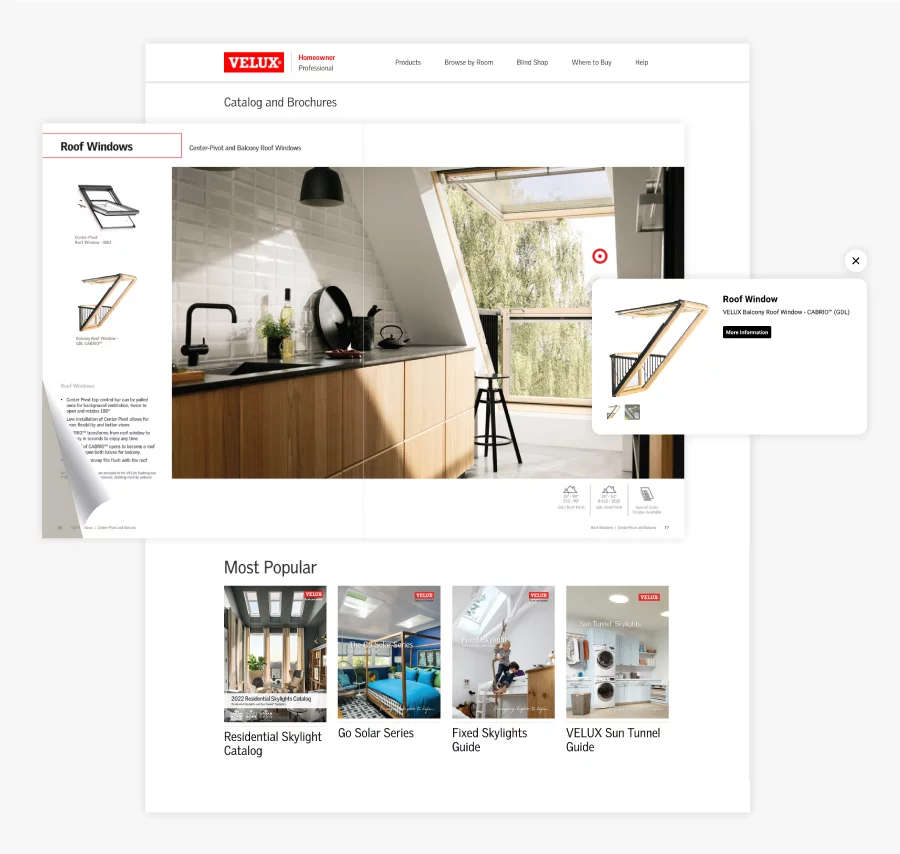
As the example above shows, with a digital catalog, you have the chance to present your products as an experience. Every video, buy button, and photo slideshow is an opportunity for your customers to engage with your content, making it a memorable experience.
Increasing your sales is a given since potential customers find your catalogs on all sorts of channels, not only if they access your website. When you successfully create structured digital catalogs, you master product spotting. Your clients will be familiar with the format you’re using and thus, will know exactly where to look for the interested products.
Crafting a good online catalog – main selling points
When going about making a digital catalog, priorities are the starting point. Once the order in which things have to be done is established, the whole process can be broken down in small parts. For example, for the design aspect, retailers have to access a collection of catalog templates. Then, customize the branding aspects, such as colors, logo, and custom fonts. With the foundation already set, you get a better understanding of the elements you need to include in a digital catalog.
Essential features of a digital catalog that converts
People working in retail might have an idea about what to include in digital catalogs, but there’s a fine line between a good catalog and one that actually converts. Put your analyst goggles on and take notes for your next product catalog, so the efforts are worth the return on investment.
There are obvious elements which have to be included in a catalog like pictures, descriptions, related products. Get into more details on how to create a product catalog here, while making a checklist with the following mentioned details to see if digital catalogs could use some improvement in order to convert visitors into paying customers.
The 6 most important elements a catalog must include:
- High-quality product pictures
- Descriptive details
- Wishlists or a Shopify integration
- Interactive buttons and pop-ups
- Customer reviews
- Return & privacy policy
1. High-quality product pictures
Every eye-catching product catalog starts with great high-quality products pictures. The options are hiring professional photographers to take them, or do it yourself if you’re on a budget. Either way, providing more angles of the same product can be an extra incentive for that visitor to become a customer. Take into consideration the way you assess products before purchasing them and try to replicate that same experience for your business.
2. Descriptive details
While you want to be as detailed as possible, you don’t want to overwhelm your audience with unnecessary information. Keep the descriptions short, easily skimmable. Include details about dimensions, different product colors, the materials, and anything else that might be of interest.
If you find that there isn’t enough information on the page, pop-ups are a great fit, since they can be dragged over a product image with more details inside. The important thing is to maintain a clean design, only presenting the basic info at first glance.
3. Add wishlists and connect with your Shopify store
When it comes to product price, it’s important to place it in a visible part of the page. It can make or break the deal for a potential customer. So make sure that when you visually scan the page, the price pops out easily.
Analyzing the market for tools that allow the option of wishlists for digital catalogs is the first step into this selling tactic. This makes it easier for visitors to add products they like directly to their wishlist, and access them through a click whenever they’re ready to purchase. It also facilitates the wholesale-retail process for everyone involved.
In order to remove the third party for Shopify, opt for integrating it into your catalog. This way, potential buyers can click on a buy button and have a pop-up open, which is connected directly to an ecommerce store. Having all the orders in the same place, while increasing sales and facilitating the buying process at the same time.
4. Interactive buttons and pop-ups
A good, stuffy collection of interactions directly influences the reader’s engagement with your digital catalog. Videos make your audience spend more time on a page, learning about your products in a more powerful way than through a static visual.
When experimenting with photo slideshows, you save a lot of design space. If before you struggled to fit all the different product angles on a page, now you can easily combine even two or three products together. Of course, there are product tags, captions, and links available to add. These elements provide potential buyers with enough details in order to purchase from you.
Think of them as call-to-action buttons. You can either use them to attract more followers on social media, as a download button or for customer feedback. Always be on the lookout for improving your audience’s experience when shopping at your store through digital catalogs.
5. Customer reviews
I personally know how many reviews I read before deciding on a product. Thus, social proof is one of the most effective ways to sell your products. Evaluate the whole buying process and see if there are some gaps you need to fill and try making it a shorter buying process.
Highlight any words of gratitude and place them strategically on your homepage but specifically, in your catalog. Seeing other customers being happy with their purchase will trigger that fear-of-missing-out response and make them curious about how it can actually make their lives better.
Re-adding in the catalog the product pictures your customers took will assure other visitors that the product is the same as the one presented in the catalog pictures.
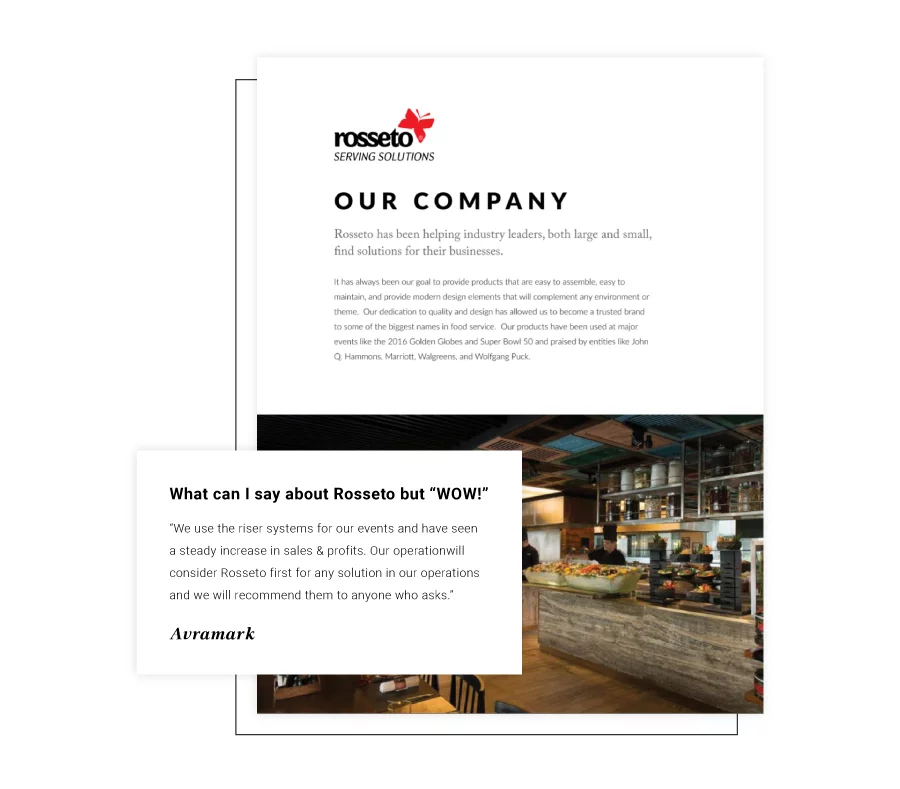
6. Return & privacy policy
For the sake of everyone’s peace of mind, it’s important to know about the return policy from the start. How streamlined the process is, if you can go into a physical store to return it, how much it costs and the time available to make the return.
Creating a page about this on the official website is a good idea. But in order to make the information easily accessible, it’s useful to include it in the digital catalogs, as well. Use go-to-page buttons for easy navigation, placed in the contents page right at the beginning of the catalog.
To avoid any unpleasant claims, also include the privacy policy regarding every client’s personal information. This saves retailers and wholesalers a lot of time in customer support hours. Depending on how client data is collected, you might have to be more or less explicit when putting together this document. Always double check this document with someone from the legal department.

4 steps to create an online product catalog in Flipsnack
After all, it’s not that difficult to digitize your printed catalogs. In fact, here is an actual design tool example, which includes every element we talked about before. Flipsnack’s Design Studio has product tags, buy buttons, and even a shopping list feature, which you can access upon request. With a Design Studio, retailers can update the information within product tags, whenever a new catalog is created, using an old design. This means less work and more time to personalize other aspects of the catalog. Users get 14 days free to test Flipsnack and the features we mentioned and see if it’s a good fit for their business. No commitment necessary, or credit card details.
There are a few steps in order to achieve a digital catalog which actually converts:
- Create an account in Flipsnack and either upload your product catalog as a PDF or start with a template. Whichever option you choose, you’ll end up with a personalized catalog in no time, full of elements that highlight your products.
- Promote your products using interactive elements like product tags, links, or shopping buttons. After you set all the details, include the price and the URL checkout for your ecommerce catalog. Facilitate the selling process on your part before sending the catalog online.
- Acquire more audience reach using various sharing options: send via email, attach to your website, or send the full-view link with no distractions. Every option is custom made to fit your exact needs, with no compromises necessary.
- Measure impact using Flipsnack statistics. Valuable insights like average time spent, number of clicks, location and devices used are available. Make the necessary adjustments for the next catalogs, be it more videos, less text, or a slight reorganization of information.
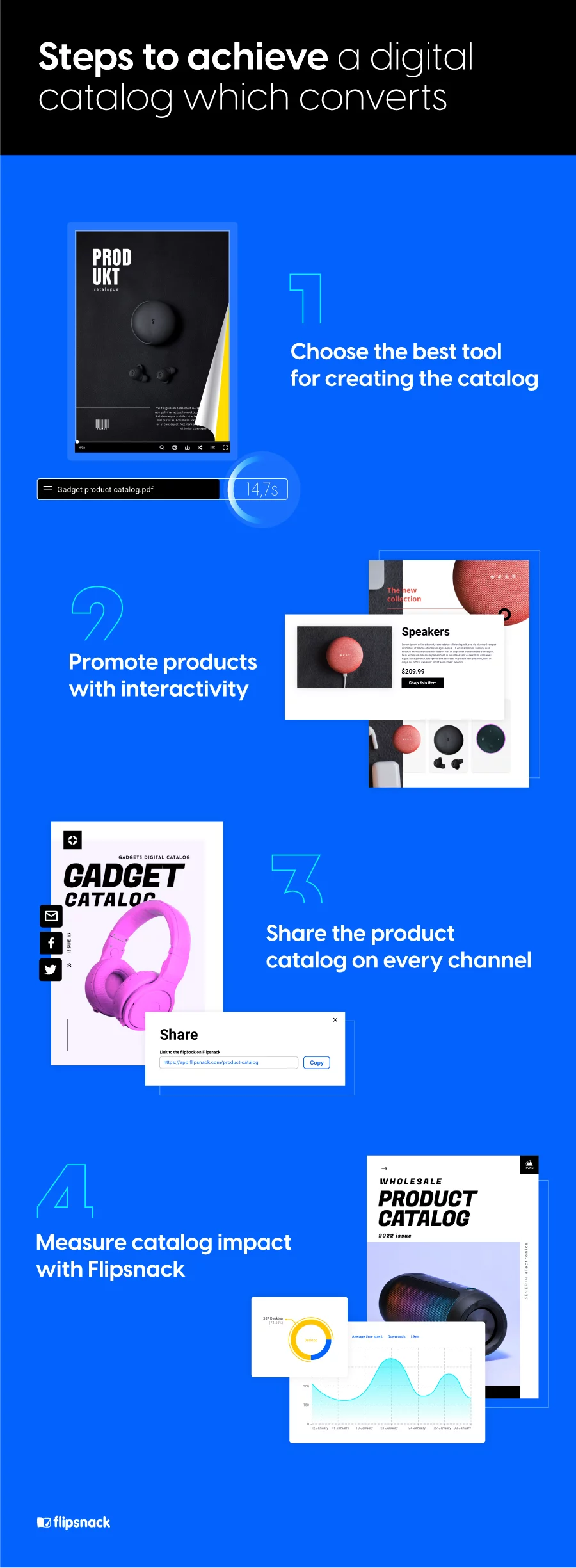
With all this arsenal of tools and information, it’s time to crack the code when it comes to ways in which to share online catalogs to always be in front of your audience.
Catalog distribution ideas, which set you apart from the competition
Online catalog campaigns have to provide your audience with different content, with a clear strategy behind. Conveying a simple message is the first step into convincing potential customers to buy your product.
Point zero is outlining your marketing goals. Do you want to raise brand awareness through your catalog? Or perhaps introduce a new product line, expand demographic reach? Whichever your goal may be, you need to identify it from the beginning.
Secondly, you can start rewarding your shoppers for the conversion they’re already making. You can provide special promo codes inside the catalogs for discounts or package-deals, so that customers feel that adrenaline when their flipping activity turns into a discount online purchase. If you want, you can create a loyalty program with bonuses for new customers.
Seasonal catalogs will never lose their charm. How many times have you ended up searching for “last-minute Christmas gift ideas for a loved one” because you kept postponing to go in-store shopping? It’s a perfect time to draw in more sales simply by creating a proper catalog design to finish the deal.
And last but not least, target customer interest with specialized catalogs. If you’ve noticed that some customers jump straight to your gardening section, then it’s a great idea to create a specialized catalog with only those types of products. Distributing a gardening-centered catalog featuring beautiful flowers bulbs, pottery, garden tools, is going to escalate the revenue chances more than an all-in-one product catalog.
What’s next for digital catalogs?
Businesses like Converse, Electrolux, Jysk, which used to rely heavily on printed catalogs, are ditching the print for digital or use a mix of the two. When we started digging into digital catalogs and how they’re used, our expectations were exceeded. With valuable insights from our big clients and based on the survey we sent, we discovered that digital catalogs are here to stay. They are becoming more and more crucial to any retail business who wants to differentiate itself on the busy market. This new digital era comes with much more opportunities than the printed catalogs era could ever offer. It’s still not too late to hop on this train leading to maximizing marketing efforts in every retail or wholesale business.
